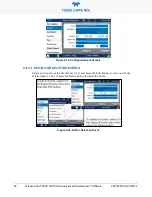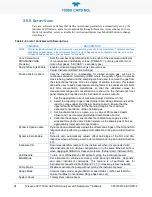
62
Teledyne API T500U CAPS NO
2
Analyzer with NumaView™ Software
083730510A DCN8172
S
ETUP
>C
OMM
(C
OMMUNICATIONS
)
This menu is for specifying the various communications configurations.
COM1/COM2
Configure the instrument’s COM1 or COM2 ports to operate in modes listed in Table 2-13.
Table 2-13. COM1/COM2 Configuration
MODE
DESCRIPTION
Baud Rate
Set the baud rate for the COM1 or COM2 port being configured.
Command Prompt
Display
Enable/disable a command prompt to be displayed when in terminal mode.
Data Bits
Set the data bits to 7 or 8 (typically set in conjunction with Parity and Stop bits).
Echo and Line
Editing
Enable/disable character echoing and line editing.
Handshaking Mode
Choose SOFTWARE handshaking for data flow control (do NOT use
SOFTWARE handshaking mode when using MODBUS RTU for Protocol mode;
select only HARDWARE or OFF for MODBUS RTU),
or HARDWARE for CTS/RTS style hardwired transmission handshaking. (This
style of data transmission handshaking is commonly used with modems or
terminal emulation protocols).
Or choose to turn OFF handshaking.
Hardware Error
Checking
Enable/disable hardware error checking.
Hardware FIFO
Enable/disable the hardware First In – First Out (FIFO) for improving data transfer
rate for that COM port.
Modem Connection
Select either a modem connection or a direct cable connection.
Modem Init String
Input an initialization string to enable the modem to communicate.
Multidrop
Enable/disable multidrop mode for multi-instrument configuration on a single
communications channel. Multidrop requires a unique ID for each instrument in
the chain (Setup>Vars>Instrument ID).
Parity
Select odd, or even, or no parity (typically set in conjunction with Data Bits and
Stop Bits).
Protocol
Select among the communications protocols: TAPI, Hessen, MODBUS RTU, or
MODBUS ASCII (MODBUS: Section 3.4.1; Hessen: Section 3.4.2).
Quiet Mode
Enable/disable Quiet mode, which suppresses any feedback from the analyzer
(such as warning messages) to the remote device and is typically used when the
port is communicating with a computer program where such intermittent
messages might cause communication problems.
Such feedback is still available, but a command must be issued to receive them.
RS-485
Enable/disable the rear panel COM2 Port for RS-485 communication. RS-485
mode has precedence over Multidrop mode if both are enabled. Also, RS-485
configuration disables the rear panel USB port.
Security
Enable/disable the requirement for a password for this serial port to respond. The
only command that is active is the request-for-help command (? CR).
Stop bits
Select either 0 or 1 stop bit (typically set in conjunction with Parity and Data bits).
Содержание T500U
Страница 2: ......
















































